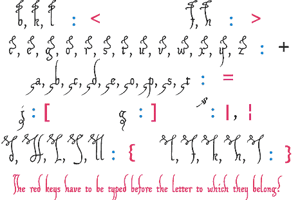MitreSquare Font
Regular Style

More info from Pia Frauss
This rather dainty font has a rather sinister background -- i.e., the murder of Catherine Eddowes by the serial killer called JackTheRipper, on September 30, 1888, at London Mitre Square. One month later, on 27th October 1888, a police inspector by the name of Jason McWilliam wrote a report concerning the events of that night. Shortly afterwards, someone whose name is not on record, made a copy of Inspector Mc William's report, which copy got its Home Office stamp on "29 OCT 88".
Luckily, this copy has come upon us, and a facsimile of it is included in that fascinating folder "Jack the Ripper and the Whitechapel murders. The true story through contemporary documents", edited by Stewart P Evans and Keith Skinner (Public Record Office/The National Archives). At least, for my part, I was fascinated by the discovery that the Ripper case has more to offer than heaps of lousy scrawls, scribbled lefthandedly by greedy tabloid editors, unscrupulous hacks, and giggling perverts -- all of them eagerly trying to pass themselves off as a serial killer who is very much in control of his hand when using a knife, but for the life of him can't produce a straight stroke when holding a pen (and, believe me, even the Lusk Letter is as fake as they come). I'd never have bothered with any of their concoctions. The McWilliam report is quite a different matter. Whoever created that copy, had clearly calligraphic aspirations. Even among the other police reports in the folder, this one stands out as an aesthetic achievement, and a miracle of elaborate elegance.
Moreover, when I chanced on that folder, I had been for some time in search of a pattern for a Victorian font -- since I'm not altogether happy with frequently seeing the JaneAusten font used as such. It's wrong on more than one level. For crying out loud, Jane Austen was Regency ... she was dead, and in her grave, before Queen Victoria was ever conceived! Worse, Jane Austen used quill pens to write -- whereas the Victorians used steel pen nibs: there is a world of difference between the blurry, blotchy, broadening strokes of the first, and the clear, precise, regular and steady ink flow of the latter. This was another weighty reason to turn the McWilliam copist's work into a font; however, considering that it is by far the most lovely specimen of Victorian handwriting I've ever come across, I hardly needed any additional inducement.
May I plead with you, then, whenever you want to create a Victorian look by using one of my fonts, not to do an injustice to Jane Austen, but to go for the MitreSquare font instead (even though there is neither a famous name, nor, sadly, any name at all, attached to it)? Pretty please...?
As for the font's characteristics, the McWilliam copist used two different es, and an amazing number of different ts. I've chosen the more frequent e, though it's the less conventional one, and have included as many differnt ts as I could cram into the font. On the other hand, I didn't go along with the copist's most frequent s -- it's barely recognizable as such --, and substituted my own K and Y for the original (rather sketchy) ones. Also, I had to fill some blanks, by creating my own U, X, and Z. And, of course, the font couldn't do without a few alternate characters.
On the number sign of the MitreSquare font, you'll find the copist's number sign (N°), for a change. The other alternate characters are
a th on the 'bar' and 'broken bar' sign. This special t only occurs in combination with an h.
an alternate g on the 'less' sign (the regular g and y don't connect well)
an alternate y on the 'more' sign (ditto)
an alternate e -- the conventional one -- on the left bracket
an alternate d on the right bracket
an alternate t on the left curly bracket
another alternate t on the right curly bracket
an alternate s on the ASCII tilde (the one with the extra stroke that joins the following character)
the ASCII circumflex has changed into an ASCII tilde.
And, concerning the image on the micro sign: I really couldn't find anything remarkable about the place called Mitre Square. Apart from that one night in 1888, there seems nothing spectacular connected to it. Therefore, I turned a bit sideways, and included an image of Christ Church, Spitalfields ... it's not too far away, I suppose.
License Info
Donations
Commercial licenses
MitreSquare Font Stats
MitreSquare Font is a Victorian font and was created on . MitreSquare Font has been downloaded 29,300 times, added to 543 collections, and liked 15 times.
MitreSquare Font was recently updated on Jun 25, 2015

